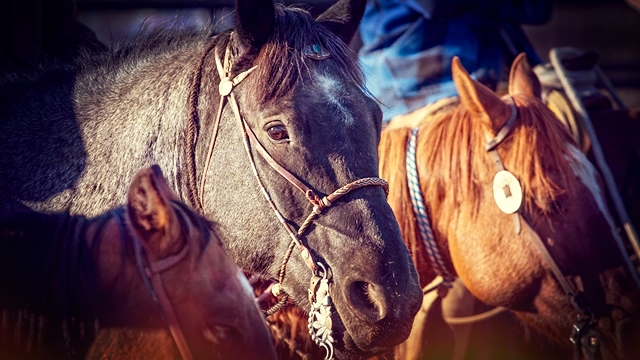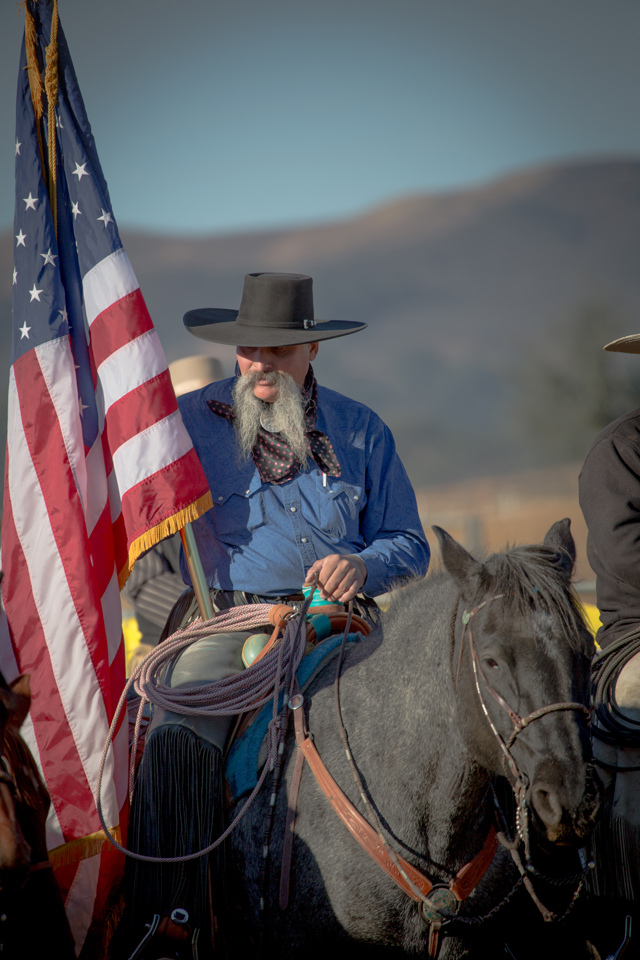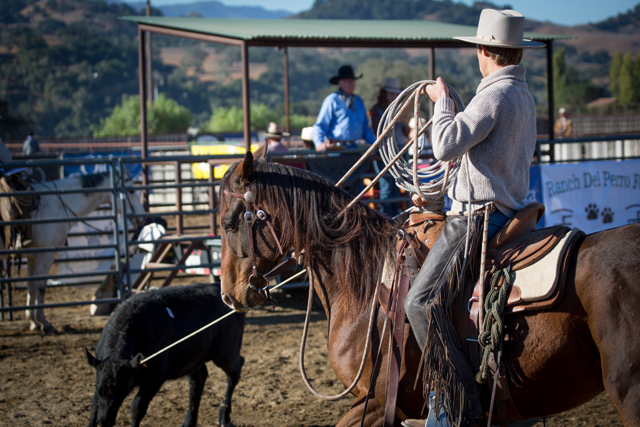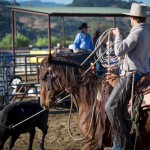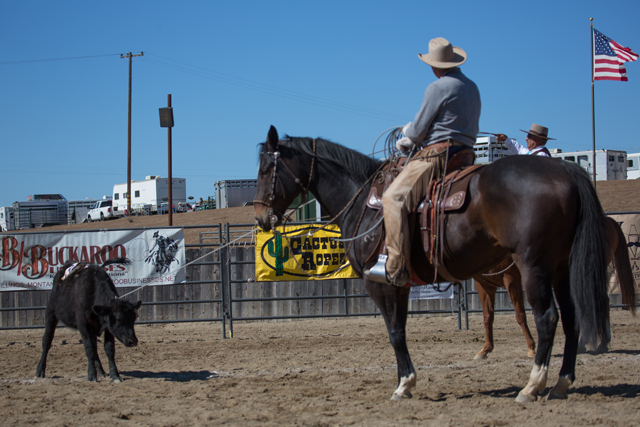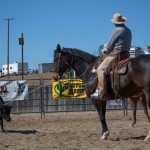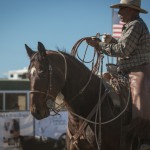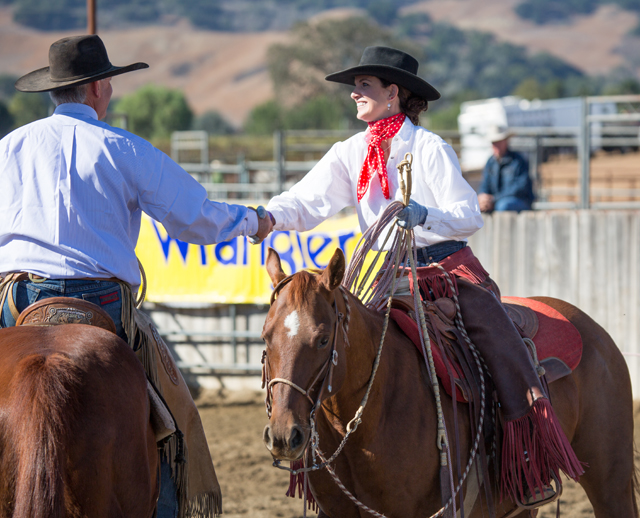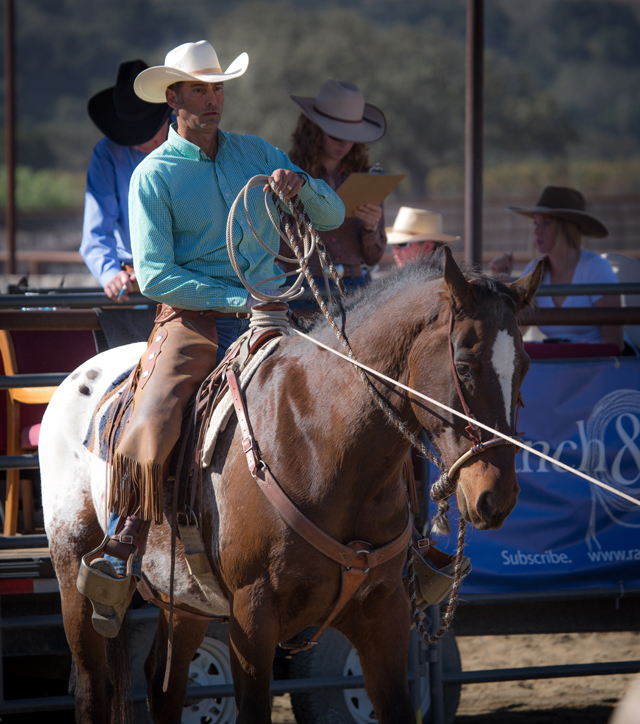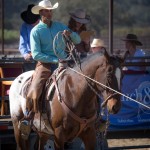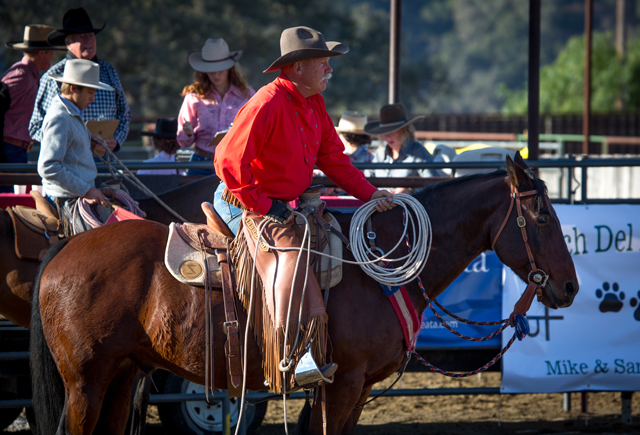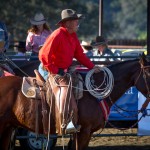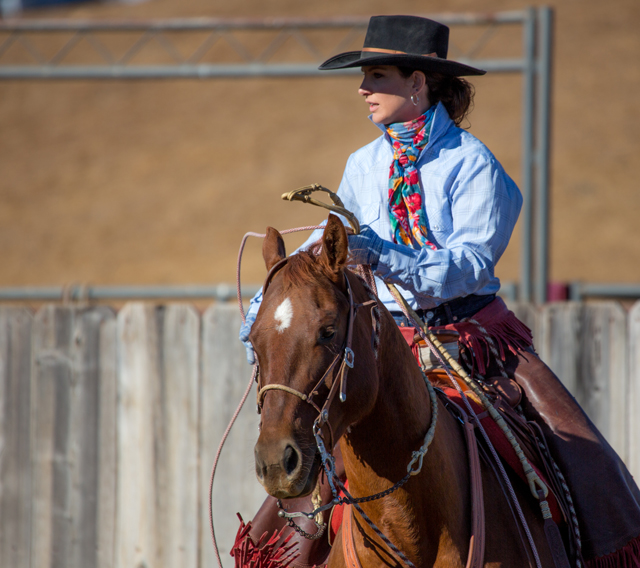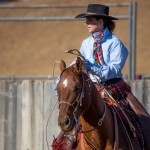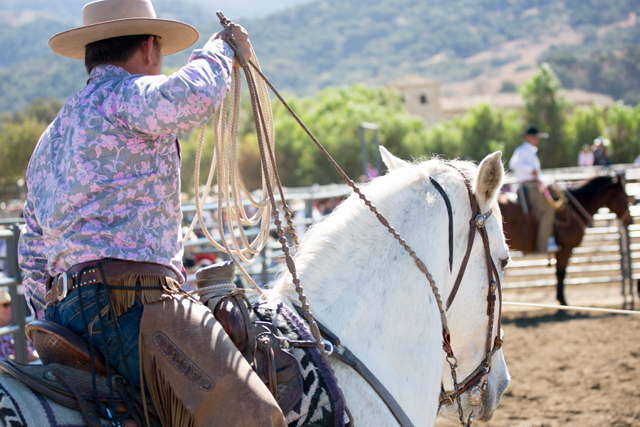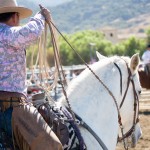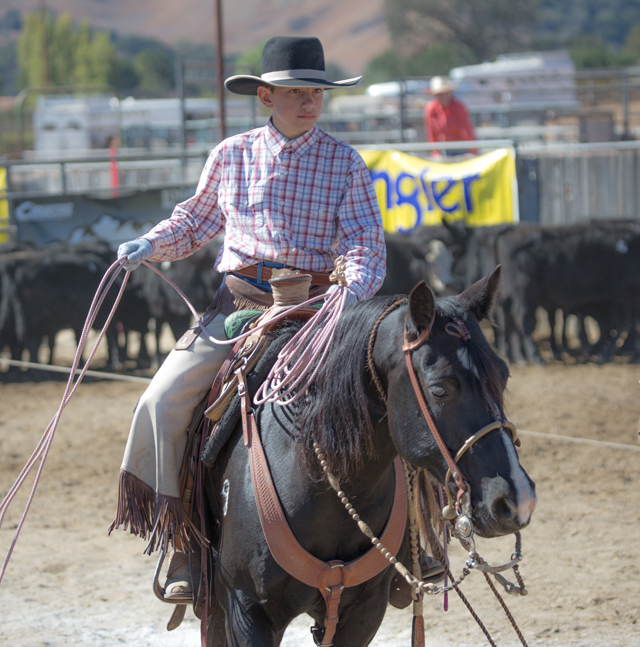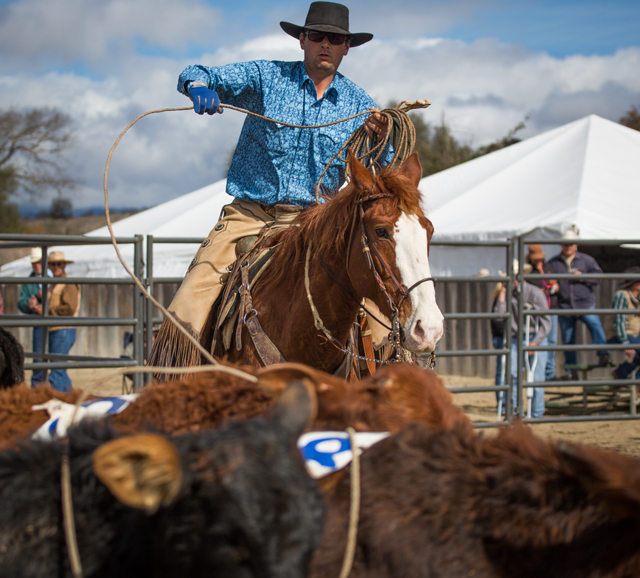
“We hit our target,” says Buck Brannaman. “We told everybody it was going to be the world’s richest ranch roping and we pulled it off.”
The 2nd Annual Wrangler Buck Brannaman Pro-Am Vaquero Roping was held October 24, 25 & 26, 2014, at the Santa Ynez Valley Equestrian Center in Santa Ynez, California.
Buck came up with the idea for this unique vaquero-style roping event building it on the model of pro-am golf tournaments where teams compete, each made up of two amateur ropers and one professional. This year, the event ran three days and nearly doubled in size from 60 to 100 teams competing.
“It was very successful,” says Bill Reynolds, the event’s co-producer. “We ended up with a purse of about $50,000, so we got to where we wanted to be. The winning team—which was really wonderful—it was Staci Grosskopf, her 14-year-old son, Sterling, and Billy Askew. With their winnings, I think they all went home with eight or nine thousand bucks a piece. So it was a real nice win for them and we paid to eighth place. We have found that it is now the largest paying ranch roping in the country. It is our intent to continue that and build on that tradition. We’d like it to be a $100,000 roping, and the way we’re going to do that is not by adding any more teams—we’re going to stay with 100 teams, it’s a good number, it’s manageable—it’ll be a sponsor-driven increase.”
Sean Sowa was on the team with Cody Dawson and Ty Van Norman that won the Horsemanship Award this year—an award showing that there is an emphasis placed upon horsemanship throughout this roping competition. Sean figures the horsemanship award represents how well a rider and his horse work together instead of against each other, and how quiet they can be while at work.
“Our goal in horsemanship,” Sean says, “is to understand one another [horse and human] and be connected and help each other out. It was really quite a great honor. I think the horsemanship award is even more of an honor than actually winning the roping because it’s quite a group of extremely handy people from all over the country [competing]. And, it’s some of the best horsemen that the world has right now. As far as what we do with this vaquero style, to be chosen out of all those people was quite an honor. We were really appreciative.”
Buck admits that selecting a winning team for the Horsemanship Award was a tough business—it’s a subjective decision.
“It’s quite a challenge for us to choose [the horsemanship award],” Buck says. “I helped the judges in that and we’re watching them for three days and it is not an easy choice to make. It came down to three or four different teams. It’s about them being smooth and handy at what they’re doing while they’re roping. It’s how you handle your horse while you’re distracted trying to do something else—working a cow and handling your rope—while still staying smooth. It’s not easy. A lot of guys can look decent on a horse when they don’t have anything else to distract them, but when you’re in a competition and you’re trying to rope and you’re thinking about where you need to put your horse to be able to get a good shot on a cow—that’s when the good horsemanship really surfaces.”
Sean admits, he thought he was a good roper when he used to team rope and calf rope, “until I saw this big loop stuff and then I had to learn all over again.”
“It’s quite a challenge,” he says, “but it’s fun because it’s never the same, there’s always something different. The rodeo kind of roping, it’s the same thing—you come out of a box, the calf might duck or dodge but it’s always the same shot. This is a whole lot more intriguing and challenging. The whole idea of vaquero horsemanship is for your animals, and to take your time and do things quietly instead of in a hurry. What people are telling us is that the whole weekend we were the quietest and the slowest—not in time, in time we actually did pretty good. But, our herd never got scattered, they always stayed quiet, so that’s what the judges liked. You’d see that theme from everybody, but it’s kind of hard when we get a time incentive—if you’re under a minute and a half you get nine points and that’s a huge jump. And we noticed that last year, you get that in your mind, but the quicker you try to get in there the more upset the herd gets and the slower your time gets.
“Last year I learned a lot from watching guys like Billy Askew and Joe Wolter—they’d just go in there and tiptoe around those cows and bump the herd and in 30 seconds the cow they wanted presented itself. It was nothing for them to neck it in under a minute and get it down. This last year at home we’ve been practicing on that and I think it paid off.”
Judging the roping competition, on the other hand, is strictly by the rule book.
“We’re trying to keep it as simple as we can,” Buck explains. “The beauty of the roping is that there’s no subjectivity—I told everybody there, the way this is judged, if the judge hates your guts, you can still win because there’s nothing personal. You can look at the score sheet or the set of rules and figure out why you won or why you didn’t. That’s nice that there is no politics or personal things enter into it. That gives it some integrity I was really hoping to have with the roping.”
Plans already are being set for next year’s Third Annual Wrangler Buck Brannaman Pro-Am Vaquero Roping. The event again will be held at the Santa Ynez Valley Equestrian Center in Santa Ynez, California. Bill and Buck plan to keep the event at the facility because it started there and they feel that:
“Santa Ynez is a ground zero for the bridle horse universe,” as Bill puts it. “It’s free for spectators, and I guess we had 1200 to 1500 people per day. The vendors were very happy. It ran smoothly. The food worked well. Buck was very happy. We had the same judges as last year in Herb French and Bob Douglas, who are the consummate professionals—they will return for 2015.”
The 2015 dates are set for October 23, 24, and 25. Another key component to a successful roping is acquiring good cattle.
“We were very pleased with the set of cattle we had,” Bill says. “We work with a fellow out of Davis, Pete Craig, who moves cattle around the state. Our difficulty with the drought here was there wasn’t a cow anywhere in the county pretty much, let alone the 185, 450 to 500 weight we needed—and boy, he delivered the most beautiful matched set of 500 weight cows you’ve ever seen. It was really good cattle and that’s what people commented on. There’s going to be a couple rule changes in that these were real bouncy fresh cows, so there was a lot of one foot catches. We really are trying to promote the idea of getting two hind feet simply because they lay down more gently. This is not a team roping. The idea is you’re handling your own cattle so you’re trying to be as gentle as possible. So, there’s going to be a point shift next year, and Buck will figure that out and we’ll put it on the website, but effectively if you get one foot you’re going to get half of what you would have got if you got both hind feet. That way it’s not so time base driven, it’s much more about accuracy, style, and concern for the animal—that’s very important to this.”
hile the top team at the world’s richest ranch roping is certainly a headline story, this year’s winners have created extra hubub. The winning team comprised amateur ropers, a mother and son team, Staci Grosskopf and her 14-year-old son, Sterling, roping alongside pro, Billy Askew.
“Drawing Billy Askew was just a great draw,” Staci says. “We were very pleased to be able to rope with him. And, really happy for Sterling and I to be able to work as mother and son.”
Their win was a result of much practice, ranch experience, and time put in competing in other ropings, according to Staci. Staci, her husband, Scott, and Sterling hail from Billings, Montana, where they buckaroo together and run Buckaroo Businesses which sells traditional buckaroo and cowboy gear.
“Roping the dummy, I started as early as possible,” Sterling says when asked how he got to such a high level as a roper at such a young age, “soon as I was strong enough to swing a rope, so two or three. I was starting to get ahorseback and rope cattle at about six. It’s my passion. I went into it, and being able to rope with 100 teams, being able to rope with such good ropers, it was an amazing feeling. The first critter, I was nervous. After that I just felt good and felt like myself.”
As with any roping, part of Sterling’s impressive contribution to his team’s success is due to his horse. Staci says when the horse, Marion, came to them he was “a pretty tough horse…he had some issues.” Sterling worked with him for some time and when discussing the Pro-Am win, he’s quick to give Marion credit.
“My horse is a black horse,” Sterling says. “He’s slower. He’s like a Quarter/pony. He’s got a blaze and a couple of socks and he’s really stout. He’s about nine now and really fun to ride. When I got him he was more troubled, nothing special, but I guess my really good feeling at Santa Ynez was to be able to bridle him up and rope there as well as we did and know that we came together the whole way.”
As Buck stated earlier, there’s no subjectivity to the judging of this roping competition. Everyone can look at the score sheets and understand why the winners won and why each team placed as they did. Without favoritism, Staci, Sterling, and Billy simply outscored the competition, but what was it like to compete against some of the world’s most distinguished ropers and win?
“You can’t help being a little intimidated roping against that many people and ropers of that caliber,” Staci says. “Towards the end, we realized it’s really keeping calm, keeping your stock calm, and getting it done as efficiently as possible. The most important thing is not to get rattled because you miss. Everyone unfortunately misses, but when you do you’ve got to not let yourself get rattled, you gotta keep going. We had a game plan every single critter we roped. We might not know exactly what loops we were going to throw, but we had a pretty good idea of what we wanted to do. It’s so amazing, there’s no other event where you have the caliber of ropers, and every level of roper roping with and against each other—that’s just a really neat opportunity. It is a little more family friendly [than other ropings], I think. It’s just a really great honor. It’s a blessing to have been able to rope there as a family—not just Sterling and I, but Scott, my husband, he got third place by time but tied by points with second place. And then Sterling also got eighth place with his grandfather.
“It’s just so important to keep this tradition alive, and this way of life because this represents what we try to do at home on the ranch with the good stockmanship and carrying on the traditions of our horsemanship and our gear and the roping. I think Buck and Bill and everybody involved has done a really nice job to get so many people involved and just help keep the traditions alive.”
Part of keeping those traditions alive is simply getting great ropers together, not only to visit with one another, but to share their time with amateur ropers and the public, as well.
“The thing that was so wonderful about this was we changed the arena configuration somewhat so there was way more space,” Bill Reynolds says about this year’s event. “The crowd could come in and mingle with the competitors. Put their chair down, go over and talk to somebody, look at the horses, look at the gear, and ask questions. The idea that there is a venue where you can come in, openly talk to people, they’re glad to talk to you, is really half the battle for us.”

An avid roper who returned for a second year to compete was Noah Cornish, a freshman at Montana State University. Noah’s family is in Chico in northern California but he currently lives in Bozeman while attending school.
“It’s definitely an educational opportunity,” Noah says. “If people are watching for it, there’s plenty to learn because some of the best ropers around go to that event. Some that aren’t the pros are still very, very good ropers. I was riding a Thoroughbred that I raised and I started when he was two. He’ll be seven next summer. I roped on him last year as well. He’s pretty handy. He did pretty good for me.”
Noah roped on two teams this year and placed 11th in the event with Isaac Johnson and pro Frank Dominguez.
“Overall it’s just a great experience,” Noah says. “They did a good job of making it go smooth and easy—just a fun event. One team I was roping with Isaac Johnson and Frank Dominguez, and we made it back to the finals on Sunday. That was just a good time—couldn’t ask for more than to get to the short deal. My other team I roped with Wes Ferazi and Dwight Hill. We didn’t do quite as good on that team as I did on the other, but it was still a kick in the pants!
“A lot of the other roping events, some of the great ropers, they come to town and gather so it’s hard for someone who maybe doesn’t rope as good as some of those pros, it’s hard for them to get a team and actually compete and win money, or at least place. At this event, everybody comes to town and draws a pro and everyone has a fair shot. The way that it’s set up, it’s really cool because no matter how you decide to go in there and do it—if you want to set up some simple shots and get a quick time you can still get to the short go. Or, if you want to take a little more time and throw some fancy shots, no matter what your capabilities are you can still make it to the short go. It’s just real fair.”
The success of the event has folks looking forward towards next year already.
“We’re thinking that we’re going to have two different divisions for the amateurs,” Buck says when asked about any planned changes for next year. “One division for amateurs that have never won any money in a ranch roping—real beginner types. And then the rest of them will be in the amateur category. There are some amateurs coming in now that are some really wolfy ropers, then there are true amateurs that are just getting started. By separating out people who have never won money before, that gives them a chance at making the finals from their division. That’s probably the biggest change we’re going to make.”
Enjoy a few photos from the event.

